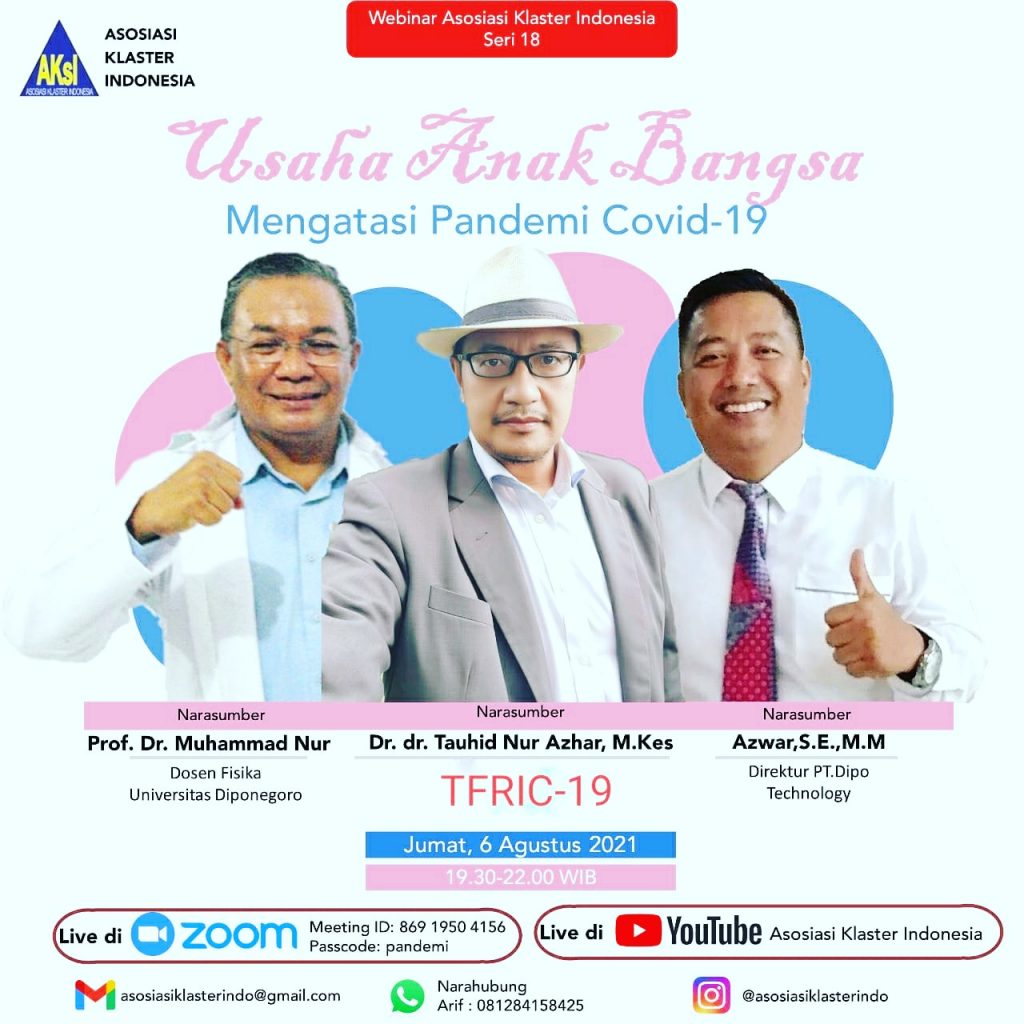
Tauhid Nur Azhar
The test that we are now facing in the form of a pandemic with Sars CoV-2 as its pathogen, in addition to having caused serious problems in the field of health also has a very significant impact into various other aspects of life. The wheels of the economy slowed and the movement of people and their activities was greatly reduced. Insecurity arises in various sectors and if not wisely addressed, it can certainly have an impact on the decline in overall quality of life.
One of the crucial issues that raises and explores in various conditions is the high potential for transmission in the space, be it in public areas such as hospitals, airports, train cabins, to office buildings.
Since social interaction is one of the most important keys to carrying out various economic processes, a concrete effort is needed to overcome and reduce potential transmission in public spaces and private areas.
Especially if we talk about safety in health facilities. In normal conditions, health facilities have high standards in terms of controlling potential transmission through airborne channels. In the pandemic with pathogens that have been identified airborne transmission is certainly needed an approach based on the latest technology that is expected to reduce the presence or charge of pathogens in the air in space.
Cold plasma technology becomes one of the very effective options in controlling the presence of airborne pathogens in space.
Prof. Muhammad Nur, DEA from the Center for Plasma Research, Diponegoro University Semarang has developed an innovation based on appropriate applied technology using cold plasma technology as its main principle. Zeta Green or air quality improvement technology is a concrete result of the development of plasma research in the Faculty of Mathematical Science Undip.
Plasma itself is the fourth material whose existence complements solid, liquid, and gas materials. Plasma is produced by the process of ionizing gas in high temperatures. Plasma has conductive properties, or is able to conduct electricity. While cold plasma technology is produced by Corona plasma reactors and DBD.
In Zeta Green technology for example, 2 plasma reactors used only require a power supply of about 80 Watts with a voltage of 220 V, and can produce cold plasma that can be used to improve the air quality in space. In the resulting cold plasma there are reactive oxygen species such as O2-, -OH, and H2O2. Also reactive nitrogen species such as NO-, NO2-, NO3-, and ONOO-. There are also ultra violets, positive ions, electrons, and electromagnetic wave emissions, all of which have the potential to regulate organic elements in the structure of viruses, bacteria, and fungi.
The existing capacity of the application of cold plasma technology as the main tool of indoor air quality improvement system has been able to reach the purification at an air volume of 100 m³ as can be seen in the test results in undip integrated laboratory. Depending on the relevant technical specifications, such as the maximum capacity of the suction fan and also the fluid dynamics of the air in the space itself.
Validity testing that has been conducted among others is by measuring the level of microbial reduction in space which among others is measured by using microbial air monitoring system (MAS-100 NT).
In addition, there has even been a test of validity and effectiveness of Zeta Green function with cold plasma technology, directly in a form of challenge test using Sars CoV-2 Delta variant virus (B 1617.2) in Biosafety Level 3 laboratory facility prof Nidom Foundation Pasuruan.
The test results are contained in the Tissue Culture Infectious Dose or TCID-50 indicator and the immune capacity of the virus. Both indicators show that cold plasma-based air purification technology has a very high effectiveness and is expected to produce maximum protection effect against virus transmission in space.
In the future, it can be considered as a post market research cooperation with biotechnology start-up Nusantics which is also developing a product to check the content of pathogens (viruses) in the air, whose products are named Nusantics Air. With the ability to take air samples in space (using biosampler water and swabs at several points on the surface) as well as reliability in conducting PCR examinations to analyze them, then if Zeta Green’s performance can be analyzed its effectiveness can certainly be a very useful objective reference for all parties.
We can get data on the ideal duration of using cold plasma technology to sterilize a room within a certain area. Furthermore, this data can be a reference for the development of standard operational procedures of the process of applying cold plasma technology in the room.
Inevitably cold plasma technology developed by Prof. Muhammad Nur, DEA who has also been produced and manufactured by a technology-based start-up company, PT Dipo Technology led by Mr. Azwar, SE, MM, is one of the concrete efforts to downstream research innovation products that have a direct impact on the process of pandemic management and control.
Dr. dr. Tauhid Nur Azhar, M.Kes. is chairman of Task Force Research Innovation Technology Covid 19

